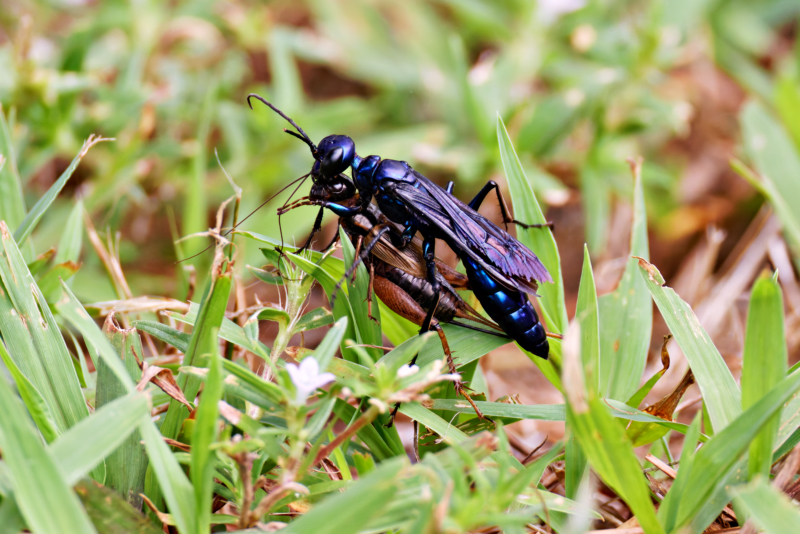On August 16, 2024, I had the opportunity to photograph a Steel-blue Cricket-hunter Wasp in my yard here in Arkansas. The wasp was walking through the grass with a cricket, preparing to drag it down into its nest—a captivating moment in the life of this remarkable insect.

Physical Appearance
The Steel-blue Cricket-hunter Wasp, scientifically known as Chlorion aerarium, is a striking insect. This wasp measures about 1 to 1.5 inches in length, making it medium to large in size. What truly sets it apart is its dark, metallic blue color, which gives it a sleek and shiny appearance. The wings are equally mesmerizing, with an iridescent quality reminiscent of an oil slick.
Behavior and Habitat
Nesting Habits: These wasps are solitary creatures, preferring to build their nests in the soil. Often, they’ll repurpose existing burrows, such as those made by Cicada Killer wasps, to create their own subterranean homes. Watching this wasp in my yard, I could see it meticulously preparing to drag its paralyzed prey into the nest—an intricate process that highlights its role as a skilled hunter.
Hunting and Feeding: The Steel-blue Cricket-hunter Wasp primarily hunts crickets, particularly those in the Gryllidae family. The female wasp paralyzes the cricket with a precise sting, then transports it to her nest. Once inside, she lays an egg on the cricket, ensuring that when the larva hatches, it has a fresh meal ready. It’s a brilliant and efficient system, showcasing the wasp’s role as both a predator and a nurturer.
Pollination: While these wasps are known for their hunting prowess, they also contribute to pollination. Though they primarily feed on oozing sap from plants, they occasionally visit flowers for nectar, playing a small but significant role in pollination.
Distribution and Ecology
Geographical Range: The Steel-blue Cricket-hunter Wasp is widely distributed across the United States and Canada. They’re most active during the summer months, with July and August being prime hunting season. Here in Arkansas, they’re a common sight during these warm months, especially in areas with plenty of crickets to hunt.
Ecological Role: Beyond their role in controlling cricket populations, these wasps also help with pollination and serve as natural pest controllers for other insects, such as cutworms. Their presence in my yard is a reminder of the delicate balance of nature and the vital roles even the smallest creatures play.
Interaction with Humans
Aggressiveness: Despite their fearsome appearance, Steel-blue Cricket-hunter Wasps are generally not aggressive towards humans. Males lack stingers entirely, and females will only sting if provoked or handled. They’re not particularly territorial, so there’s little reason to fear them—unless you’re a cricket!
Final Thoughts
The Steel-blue Cricket-hunter Wasp is more than just a predator; it’s a fascinating creature that contributes to the health of our ecosystem. Its striking appearance and intriguing behaviors make it a captivating subject for observation and study. As I watched this wasp in my yard, I was reminded of the incredible diversity of life that surrounds us, even in our own backyards. Whether you’re a seasoned naturalist or just someone with a curiosity for the natural world, the Steel-blue Cricket-hunter Wasp is a species worth getting to know.
